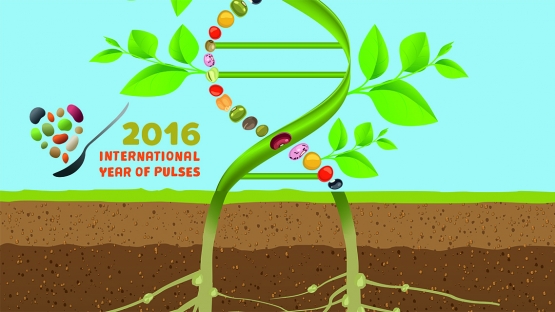An event to celebrate the International Year of Pulses (2016) took place this week at the Vienna International Centre. The year 2016 was declared the International Year of Pulses by the 68th UN General Assembly to help raise public awareness of the nutritional benefits and the role of pulses in sustainable food production.
The Joint FAO/IAEA Division of Nuclear Techniques in Food and Agriculture organized this event to highlight the role of pulses in enhancing the sustainability of agricultural cropping systems. Pulses contribute to increased food security, human health and wealth and can help mitigate the effects of climate change. A variety of pulses and pulse plants were displayed with their nitrogen-fixing roots and nodules visible. Also presented were mutant pulse varieties that have been officially released in Member States. A slide show and infographic materials summarised the important role of pulses, and different pulse foods were cooked for tasting.
Pulses contain plant-based proteins, minerals, amino acids and other nutrients in human diets and cover about 57.3 million hectares with a global production of 40 million tonnes. They are able to fix atmospheric nitrogen through nodules in the soil and reduce the need for industrial nitrogen fertilizers and therefore boost soil fertility, are environmentally-friendly and provide a more sustainable crop yield. The work of the Joint FAO/IAEA Division has shown that yield can increase from 20% to 35% when a crop of spring wheat or barley is grown after a pulse crop. Pulses extract water and nutrients from soil through their deep roots that minimise the impact of surface water stress. They are highly water efficient and use much less water than other crops.
The event also highlighted the role of nuclear applications as related to pulses. The stable isotope of nitrogen, 15N, can be used to identify pulses and legumes with high nitrogen fixing abilities and to quantify the amount of nitrogen fixed. The Joint FAO/IAEA Division has been assisting Member States in developing 15N isotopic methodology to identify pulses and legumes with high nitrogen fixing abilities for the past 30 years.
Besides improving soil health, pulses also contribute to climate change mitigation. Field studies using isotope techniques in Member States have shown that less nitrous oxide is emitted when pulses are used as fertilizer as opposed to chemical fertilizers. The Joint FAO/IAEA Division is currently developing protocols to measure carbon dioxide and nitrous oxide greenhouse gas emissions in legume-based cropping systems.
Nuclear techniques are helping to improve yield, enhance food security and broaden the genetic diversity of pulses. New varieties are well adapted to climate change and support climate-smart agriculture. The Joint Division is addressing a wide range of crops in its work, but has put a special emphasis on pulses this year. It has helped to release over 100 mutant varieties in different countries, including the common-beans IAPAR 57 and IPAR 65 in Brazil, that are resistant to the golden mosaic virus and the mung-bean Chai Nat 72 in Thailand that is tolerant to the bean fly.




